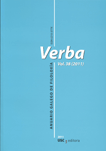Poligrafías medievales extrañas: cuando camin(o) se hace camion
Contido principal do artigo
Resumo
El presente artículo tiene como objetivo el análisis de ciertas alternancias gráficas que se presentan en documentos notariales del medievo asturiano, concretamente de los siglos XIII y XIV. Dichas grafías, procedentes de la terminación latina –INUM, aparecen en nuestros textos escritas como –ino, -in e –ion. Queremos resolver si esta alternancia evoca diferencias de sonido y, por ello, tiene trascendencia fonética; o si, por el contrario, es simplemente gráfica y, en este caso, esa diversidad se justificaría como un error por parte de quien escribe o se trata de sus conscientes y motivados.
DOI http://dx.doi.org/10.15304/verba.41.1454


